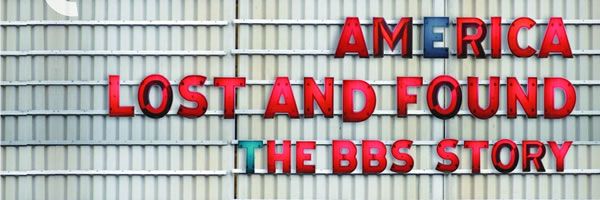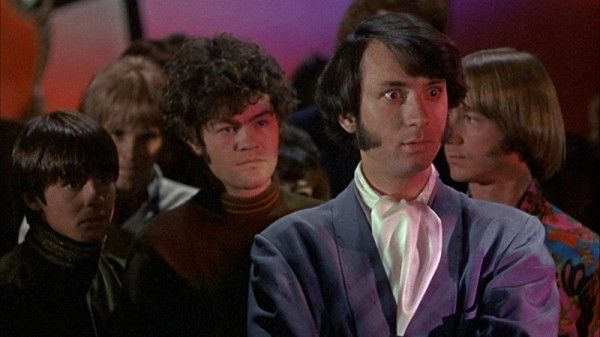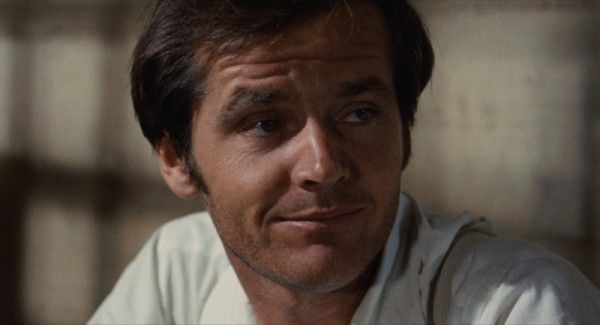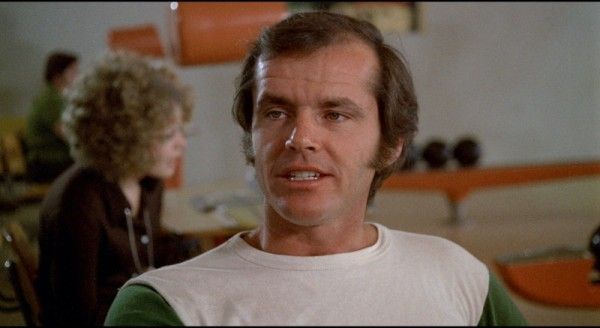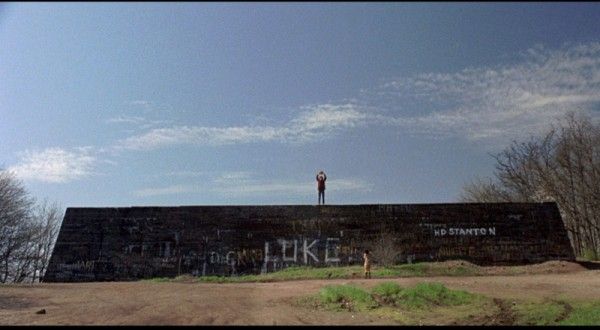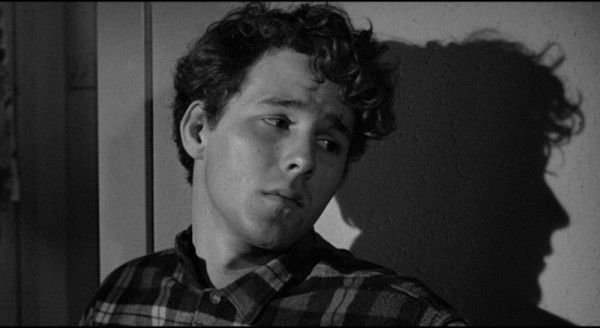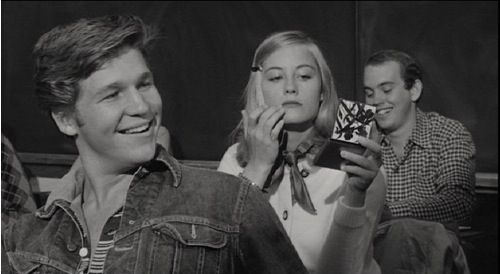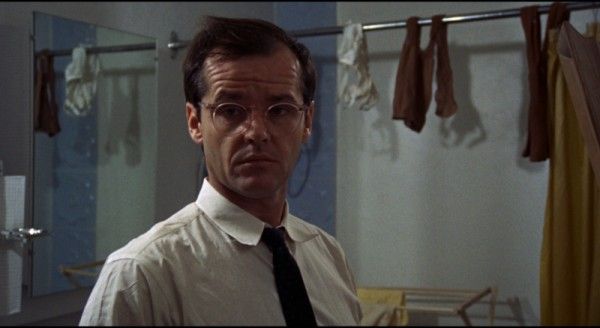Bob Rafelson started a production company called Raybert (a combination of his name and producer Bert Schneider) when he was working on the Monkees television show. But Rafelson had cinematic aspirations, and so he took the Monkees to the big screen and started a production company with Bert and Steven Blauner called BBS. Between Raybert and BBS they made seven films: The Monkees’ feature film Head; Dennis Hopper’s seminal biker movie Easy Rider, Rafelson’s masterpiece Five Easy Pieces, Jack Nicholson’s directorial debut Drive, He Said, Henry Jaglom’s first film A Safe Place, Peter Bogdanovich’s career starting film about small town sexuality The Last Picture Show, and Rafelson’s The King of Marvin Gardens. Seven film in four years, with regulars Karen Black, Jack Nicholson, Bruce Dern, Ellen Burstyn, and stars like Peter Fonda, Cybil Shepherd, Jeff Bridges, and Orson Welles, made during one of the most tumultuous and artistically rewarding periods of American cinema. This is why the Criterion Collection exists, and America Lost and Found: The BBS Story is one of those great collections in that it documents the progress, and success and failures of this organization. My review of the Blu-ray set of the film follows after the jump.
The collection starts with Head. Though it’s one of the greatest titles in cinema history, the film itself is more fascinating than great. If Rafelson was aiming for the success of Richard Lester, he failed miserably and it’s one of the rare films that deserve the label pretentious. But like a lot of things pretentious, there is also something fascinating about something that tries this hard (and misses). Peter Tork, Davey Jones, Michael Nesmith and Micky Dolenz are/were The Monkees, and in their feature film debut they run from weird set-piece to set-piece in what all evidence suggests was a very drug inspired screenplay (by Jack Nicholson and Bob Rafelson). In one bit Jones is a prize fighter up against Sonny Liston and with Annette Funicello as his girl. In another bit they’re dandruff in Victor Mature’s hair and get sucked into a vacuum. It’s a pop-art collage that seems drawn slightly from the television show, but taken much further in terms of out and out weirdness. My read of the picture, though this is commented on nowhere was that Jones was having issues with the band as he’s off on his own adventures for much of the film (though every Monkee gets their own section of the film).
Perhaps the greatest moment in the film is where the film breaks the fourth wall and the cast interact with Rafelson, Nicholson, and Dennis Hopper (who wanders through a frame), and you can argue that something resembling a torch is being passed, or that there’s a generation shift being made apparent. The film also traffics in cameos, so besides the people listed, Timothy Carey shows up as an insane cowboy, Frank Zappa offers musical advice, Teri Garr plays a cute girl, and so on. Unfortunately the film spills into pretention when it cross=cuts girls screaming for musicians, with images of violence from Vietnam. But this then raises a question: if it were Godard or someone of his stature doing such cross-cutting, wouldn’t it be inspired? Rafelson and company knew that they had created a phony band, and the group – such as they were – was good but inorganic. By the film (at times) acknowledging their own construction, is that pop deconstruction or (as there is no real there) just another façade? Is it like professional wrestlers admitting the sport is fake? In his book “Easy Riders, Raging Bulls,” Peter Biskind described the film as Rafelson’s 8 ½ but done as his first film, and as vacuous as that implies. At the same time, the music is great, with songs provided by Nesmith, Tork, Carole King and Harry Nilsson.
The Criterion version presents the film in widescreen (1.78:1) and in the original uncompressed monaural soundtrack and a brand new DTS-HD 5.1 Master Audio track that is excellent. The film also comes with a commentary track by The Monkees (recorded separately), and they offer some insights, but are often distracted. The Supplements section kicks off with “From the Monkees to Head” (28 min.) gets Rafelson talking about both the TV show and how the film came about, and the marketing, and some thoughts on his drug use at the time. He’s honest, so it’s great. “BBS: A Time for Change” (28 min.) gets historian/critics David Thomson and Douglas Brinkley to talk about what this company did and meant for cinema. This is followed by screen tests of all four Monkees, and two practice scenes (19 min.), the Monkees promoting the film on “The Hy Lit Show” (6 min.), four trailers, and five TV spots, nine radio spots, and a still gallery with audio outtakes (7 min.).
Next up in the set is Easy Rider. The film is relatively simple in the scheme of things, but no less effective. I first saw the film as a college student, and found it too simple for its own good, too much a product of its time. Now I think on the film much more fondly as a road picture, and also putting the film in its context helped. The film was a massive success for everyone involved, and more than any other picture in this box set really did change Hollywood. It and opened the door for lower budget pictures, and likely led to more work from those who would be considered masters now. Done on a small budget, the film was a global success, transcendent of its biker picture/ B-movie roots. Does it say anything profound? Not really, but it’s definitely a zeitgeist picture. And it’s a road picture – what’s amazing about the film today is when you remove some of the more extreme visual stylizing, it follows a well trod formula. This was also the first film to revolutionize film soundtracks with its use of popular music over a score. To this day, there are still filmmakers who use “Born to Be Wild” as a signifier because of this movie. The title is part of the pop culture consciousness, so much so a Full House episode was named after it. Everything about it has been absorbed, and arguably neutered.
Dennis Hopper directed and stars as Billy, along with Peter Fonda’s Wyatt, as two Los Angeles bikers making their way to the promise-land. In their case that’s New Orleans (for Mardi gras), and with them is a gas tank full of money after their last big score. They mostly camp outside as they’re not welcome in most motels, and few will take them in because of their long hair and motorcycles. They end up at a commune, and then pick up George Hanson (Nicholson) in what became a star-making performance as a town drunk/lawyer who hops on the back of their ride. Once they get to New Orleans they spend some time with some prostitutes (Karen Black, Toni Basil), but in one of the film’s most celebrated sections, Wyatt suggests that they blew it.
Whatever “it” is is open for interpretation. Did they sell out, did they not change anything? The film was made in 1968 and 1969, released a year after one of the most tumultuous years in American history. But the weight of Nixon’s election had to weigh heavily on the filmmakers and their sense of the world. These two men – named for cowboys – are meant to have connections to the Wild West, and are in their way running away from civilization as with many of their western counterparts, but they are also doomed. But in this case, their fate is predicated on not a moral compass of the filmmaker, but the culture (then) at large. Because the film has been picked apart so thoroughly, there’s nothing all that subtle about Jack Nicholson’s character saying that the hillbillies and such hate Billy and Wyatt for their freedom. But at the time, the us vs. them nature of society was a powerful thing. Even if that’s gone now, people like Glenn Beck, Rush Limbaugh and Bill O’Reilly (and Cartman) still rail against hippies and the Woodstock movement, and this is definitely of that. But it’s also a road picture, and – working with cinematographer Laszlo Kovacs, it’s a gorgeous film to watch.
The film comes in widescreen (1.85:1) and in the film’s original uncompressed monaural soundtrack, and DTS-HD Master audio in both 2.0 and 5.1 surround. The film was previously released by Sony on Blu-ray, but this has better supplements, and a better transfer – picture quality is modestly improved with a transfer supervised by Kovacs. There are two commentary tracks, one with Dennis Hopper going solo (from 2009), and the second with Hopper, Fonda and production manager Paul Lewis from the laserdisc special edition (from 1995). Hopper and Fonda had money disputes on the film, and Hopper has (as with a number of great auteurs) suggested that the film and its script was all his work, so the ‘95 track is more genial. This disc also has the most extensive supplements. “Born to Be Wild” (30 min.) was done in 1995 for the BBC, and gets Hopper, Fonda, Henry Jaglom (who was very involved in the post production, and supposedly “fixed” the film), Kovacs, and Karen Black to talk about the film. This is followed by “Easy Rider: Shaking the Cage” (65 min.), which adds Luke Askew, Paul Lewis associate producer Bill Hayward, and Seymour Cassel to the mix of interview subjects. As to be expected there’s a bit of overlap between the two in terms of the point of view and commentary, but between the two and the commentaries, you get the sense that its makers have said all they ever were about the film. The film played Cannes, and “Hopper and Fonda at Cannes” (2 min.) offers interview footage from the fest. Then there’s an interview with Steve Blauner (19 min.) about BSS, and how he became involved because of his childhood connection to Bert Schneider. This is followed by two theatrical trailers.
Five Easy Pieces was Bob Rafelson’s follow up to Head, done in 1970. He says on the supplements of Head that after that experience he never wanted to make another edit driven film. That’s the only real evidence that would suggest his leap forward with Pieces, which is one of the greatest of American films – from the 1970’s or of all of cinema. Jack Nicholson gives a career best performance as Robert Dupea, who’s introduced as an oil rig worker with his buddy Elton (Billy “Green” Bush), and who lives with his girlfriend Rayette Dipesto (Karen Black). From their first scene together, their relationship is laid bare. She’s emotionally needy, and he’s cold, constantly holding out his feelings, and constantly demeaning her. But she takes it. One of the key exchanges is that she asks him to tell her he loves her, and he responds by saying that it’s okay if she sings to him (which she asked to do earlier). On one level he’s trying to give her what she wants, but in doing so he can’t help but do it indirectly. Dupea’s back-story is revealed slowly. He’s a classically trained pianist from a family of musicians. He goes to see his sister Partita (Lois Smith), and is told that his father is ill, and has had a debilitating stroke. When he’s let go from his job, he decides to go see his family, and Rayette wants to tag along (she’s threatened suicide before). Bobby reluctantly takes her, and along the way (along with some hitch-hikers) they stop at a diner in what has become the film’s most memorable/quotable scene. Everyone remembers the “I want you to hold it between your knees” but I’ve always felt the most important part of the scene happens moments later in the car where he’s being told how great it was how he did that and he responds “yeah, but I didn’t get what I wanted.”
He leaves Rayette at a hotel and goes home to find his father alive, but mentally gone and his brother Carl (Ralph Waite) teaching a pretty young woman, Catherine Van Oost (Susan Anspach). Partly because there’s nothing else to do, Bobby goes about seducing Catherine, but then Rayette comes up, and it’s revealed that Catherine and Carl are engaged.
Though it doesn’t come up in the supplements, I wonder how much an influence Catcher in the Rye had on screenwriter Carol Eastman and Rafelson. Dupea is a child of privilege who rejects his family and pursues a working class life, but also hates dumb people, and hates most things. His relationship with Rayette is based on need, but it’s readily apparent he doesn’t respect her in the slightest. He also – quite obviously – hates himself. He’s a phony, for sure. But the way Nicholson plays him, he’s fascinating regardless of whether he’s a shitheel or not – and he is an asshole, of that there is no doubt, but he’s also searching for something. He may be a fun shitkicker in the opening section of the film, but once his family comes to light, the character deepens, and shows all facets of his troubled mind. Though I can imagine this film being off putting, the sense of being neither fish nor fowl, only knowing what you don’t want, everything this film tackles is expertly handled by its cast and crew. This is one of cinema’s great character studies, with a lead performance by one of its great actors. Everything is firing correctly, and the yearning at the heart of the film is timeless.
The Criterion Collection presents the film in widescreen (1.85:1) and in its original monaural soundtrack. Extras include a commentary by director Rafelson that’s fairly honest, and he talks about how one scene he shot he’s never seen, and never wants to. He’s joined by interior designer and ex-wife Toby Rafelson. This is followed by the featurette “Soul Searching in ‘Five Easy Pieces’” (9 min.) that gives Rafelson another chance to summarize his feelings for the movie, and what it’s all about. It’s followed by “BBStory” (47 min.) which talks about the production company and their films with Rafelson, Bogdanovich, Jaglom, Nicholson, Karen Black and Ellen Burstyn along with Bruce Dern, Fred Roos, Timothy Bottoms, Richard Shickel and Micky Dolenz. Basically it walks through each film in the company’s history and their place in cinema history (or lack thereof). Bottoms has a beautiful moment where he talks about how a scene in Last Picture Show echoed a scene in his life that’s one of the most poignant moments I’ve ever experienced from a supplement. There’s also an AFI conducted Rafelson audio interview (49 min.), two teaser trailers and the film’s theatrical trailer.
The next disc includes two films, 1970’s Drive, He Said, and 1971’s A Safe Place. The first was Jack Nicholson’s first stab at directing. He deals with a college kid named Hector (William Tepper) who’s on the basketball team, likes fucking and doesn’t want to go to war. A character sketch, with supporting turns from Karen Black and Bruce Dern, you can see what Nicholson’s going for, but his goals and accomplishments are modest. The film comes in widescreen (1.85:1) and in monaural sound, with a featurette on the making of called “A Cautionary Tale…” (11 min.) and the film’s theatrical trailer.
Also on the disc is A Safe Place from Henry Jaglom. Jaglom is one of those guys who’s been churning out films for years, and has an audience, but has never been an award winner, and no one film of his has a champion. And so I dutifully watched this hoping I’d find my way into Jaglom’s hold and/or ability to keep getting financing. Alas, I saw a movie that came across as deeply bullshit. Amateurish, etc. Tuesday Weld stars as Susan/Noah, who’s been having relationship troubles with Fred (Phillip Proctor), partly because she’s still fucking Mitch (Jack Nicholson), or is she, or who is she? Then there’s Orson Welles playing a magician, who delivers monologues and does magic. Grrr. The film comes widescreen (1.85:1) and in monaural sound. The transfers for both these films are note perfect. Extras include a commentary by Jaglom, the featurette “Henry Jaglom finds A Safe Place” (7 min.), an interview with Jaglom and Bogdanovich by Molly Haskell (29 min.), outtakes and four screen tests (25 min.), and the film’s theatrical trailer.
Peter Bogdanovich’s The Last Picture Show follows, and the interview on the previous disc showcases that Jaglom knew his picture was doomed in a way, and couldn’t talk about it on the interview circuit. Bogdanovich, poised with a cigarette in hand, is totally on point, and knows exactly what he’s doing. Then again Bogdanovich began his career in film as a journalist. But that’s not why he comes across as preternaturally confident. He had his movie, and he knew it. Though it was his second film, Picture Show is also something of a first as Targets - his inaugural entry - was done as a bet with Roger Corman. Here he was adopting the Larry McMurtry novel with the author himself for the big screen.
Timothy Bottoms stars as Sonny Crawford, best friends with Duane Jackson (Jeff Bridges). The two play on the local football team together (which is always losing). Duane dates Jacy Farrow (Cybil Shepherd), the local prom queen type, while the film begins with Sonny breaking up with his current girlfriend when she won’t have sex with him. Sonny isn’t single for long, as a trip to help the coach’s wife Ruth Popper (Cloris Leachman) leads to an affair. Jacy is courted by others, and she goes to a wild party (with Randy Quaid in his first film role), and when an older gentleman won’t sleep with her because she’s a virgin, she goes about losing it with Duane, and then starts to test the waters, eventually sleeping with Abilene (Clu Gulagher), her mother Lois’s (Ellen Burstyn) lover. In town there’s Sam the Lion (Ben Johnson), the unofficial head of the town and surrogate father for Sonny and Billy (Sam Bottom), the town’s retarded child.
Covering roughly a year in the small town, it concludes with Duane heading off to Korea, and the town’s sole movie theater closing as the characters try to make amends. But what gives Bogdanovich’s film its kick is that it applies the then-new European sensibility to sexuality to Middle America. Though Jacy has been criticized as being a reflection of her male’s creators, Shepherd (in her first onscreen role) gives the performance a life: her character knows she’s attractive, but doesn’t understand sex so she goes about getting experienced, which leads to a quickie marriage and annulment. For the boys sexuality is just as weird and unexpected. Duane and Jacy get a hotel room, and he finds that put under the gun he’s got performance anxieties, so both pretend for everyone that it was a great time, while when Jacy experiments she finds that good lovers aren’t always good boyfriends.
But with Ben Johnson’s Sam the Lion – much like Easy Rider – it’s a western in disguise as it’s about the end of an era, and the folding in of one culture into another. But for McMurtry’s characters there is no Mexico to flee to, just the wreckage of their lives, and maybe a trip to Korea. In that way the film – which faintly traces some John Fordian sensibilities – is an extension of the world in a modern setting. Bogdanovich knew what he was doing, and the film is a meaty text.
The film comes in widescreen (1.85:1) and in monaural sound. The film comes with two commentaries, one done for the laserdisc in 1991 with Bogdanovich, Shepherd, Quaid, Leachman, and location manager/actor Frank Marshall, and a 2009 track with Bogdanovich by himself. The ’91 commentary came after the film was reissued theatrical, and had a couple minutes restored. It should be noted that the film’s original theatrical release has never been put to home video, but the differences are such that no one’s ever complained. “The Last Picture Show: A Look Back” (65 min.) gets Bogdanovich, Larry McMurtry, Leachman, Shepherd, Bridges, Burstyn, and Marshall to talk about the film, done for the film’s DVD release in 1999. It’s puffy. This is followed by a 2009 Q&A with Bogdanovich (13 min.) and “Picture This” (42 min.), the late George Hickenlooper’s documentary on the town the film was set and the first film, with interviews with the director, Shepherd, McMurtry, Bridges Polly Platt, Randy Quaid, Tim Bottoms, and more. This is followed by screen tests for local color (2 min.), and location footage (6 min.). This is followed by an interview with Francois Truffaut (5 min.) where he praises the film and the new Hollywood. There’s also the film’s original trailer, and a re-release trailer.
The King of Marvin Gardens is the final film of the set, and it’s an interesting, but modest film from Rafelson. The film is about a quartet of performers. Jack Nicholson plays David Staebler, a radio DJ who often exaggerates his life for his audience. His brother is Jason (Bruce Dern), who’s got a stake in Atlantic City, where he hustles for a living. There he lives with Sally (Ellen Burstyn) and Jessica (Julia Anne Robinson). Sally is the older of the two and possible step-mother to Jessica, the world-be Miss America contestant type. Jason spends his time putting deals together, but as David comes out to meet him, Jason’s arranged for a marching band, and his ladies to meet him, but Jason can’t be there because he’s in jail. Jason’s been in trouble with Lewis (Benjamin “Scatman” Crothers). While David is hanging out with his brother, he sees that his brother is full of ideas and can inspire, but he’s also a hustler with bigger dreams than means, and is talking about going off to Hawaii as most dreamers talk about the thing they’ll obviously never get to in their life.
Tumult erupts, but it’s mostly internal, especially as Sally doesn’t like the idea of growing old and less desirable. The star of the film is Bruce Dern, and it’s a showcase of a role. Nicholson mostly internalizes everything though – like Five Easy Pieces – it does lead to him have an emotional breakdown/breakthrough. This is never as precise or as perfect as that film, but as a stand-alone piece, there’s a lot to admire here, and the performances and visual design (By Kovacs) is excellent. It just feels more modest and muddled than their previous effort.
The Criterion edition presents the film in widescreen (1.85:1) and in monaural sound. Extras include a selected-scene commentary by Rafelson (61 min.) which covers over half of the film. This is followed by “Reflections of a Philosopher King” (10 min.) with Rafelson and Burstyn talking about the movie. “Afterthoughts” (11 min.) appears to be from the previous DVD release, with Rafelson, Dern and Kovacs talking about the film. The set concludes with a brief bio and filmography of Rafelson, and the film’s theatrical trailer.
[some screen captures courtesy of DVDBeaver]

